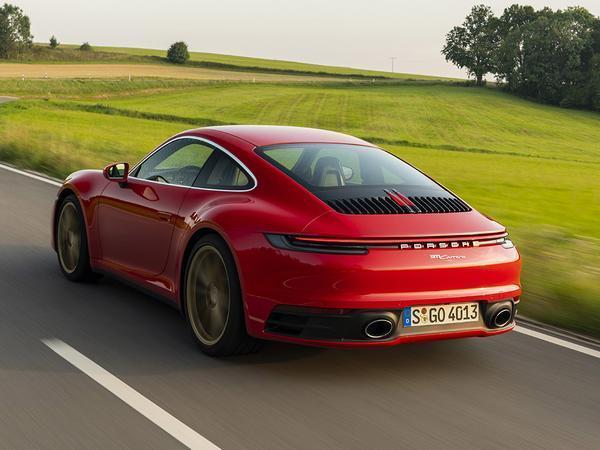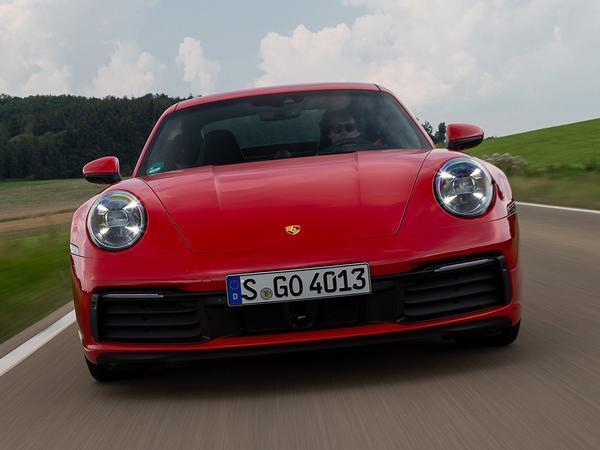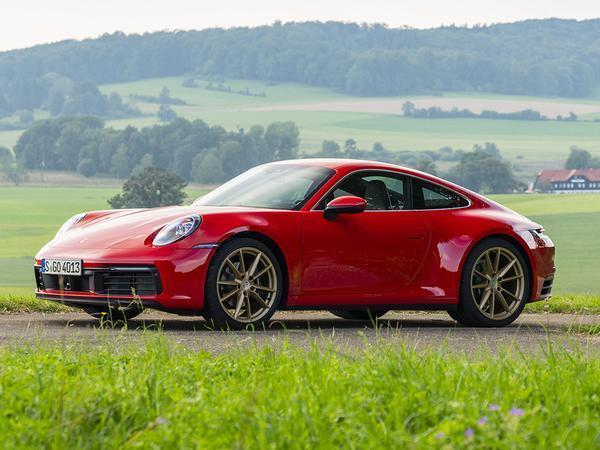With the 992 a more complex 911 than ever, could the best Carrera be a basic one?
Once upon a time, there were quite noticeable differences between a 911 Carrera and a Carrera S. They had engines of different sizes, most significantly, as well as wider bodies for the four-wheel drive cars. As you’re probably aware, that’s gone with the 992; all of the Carreras, be they two- or four-wheel drive, hardtop or soft-top, Carrera or Carrera S, use the same body and the same 3.0-litre, twin-turbo flat-six. Sure, the S uses different turbines and compressors for its power gain, though the prestige that might once have lain in owning the larger-engined Carrera has gone. It would appear that the two are closer than they ever have been, basically, and don’t forget that the base 992 Carrera is now as powerful as a 997.2 Carrera S, with a wedge more torque. On paper, it is no lesser sibling.
At 1,505kg DIN, the Carrera is 10kg lighter than an S. With 385hp and 332lb ft, it’s capable of 0-62mph in 4.2 seconds, 0-100mph in 9.3 seconds(!) and 182mph. That the biggest talking point might be the fitment of 19-inch front and 20-inch rears as standard (where the Carrera S has 20/21s) shows you how similar the cars should be.
And wouldn’t you know, that’s just how things feel on the road. Everything that’s familiar from the 992 era of 911 is present and correct here: the impression of being really quite large, the uncannily adept damping, steering about as good as EPAS gets, an immaculate PDK gearbox and the sort of refinement never before known in a 911. It’s a really lovely thing.
When pushed, however, there is a discernible difference in performance – the Carrera does give away 65hp to the S, as well as 59lb ft, after all. So there’s never the ferocity delivered by the more powerful car, although it should be noted that the characteristics remain similar: it really is a superb turbo engine. There’s a crispness to the throttle response associated with more expensive cars, vast, effortless torque from even lower engine speeds than the S and a real enthusiasm for revs – even once beyond peak power at 6,500rpm. With the sports exhaust fitted the noise is an intriguing one too, flat-six gargle allied to turbo whooshes and a searing top end, the latter incredibly loud in fact. Being a tad slower means there’s more time to appreciate it, too…
So what of the wheel swap? Well, it’s impossible to say, since all test cars on the launch were optionally equipped with the larger wheels amongst a smorgasbord of options – d’oh. No surprises, then, that the standard Carrera felt rather like an S, borderline identical in fact, which is to say pretty damn good. Certainly there’s no impression of it being in any way inferior, steering with the same accuracy and consistency, riding plushly yet with flawless control, braking with the confidence and authority we’ve come to expect of Porsche sports cars.
With less power and torque but the same amount of rubber on the road (in this instance, at least), there’s even less scope in a Carrera than a Carrera S for much in the way of tactile involvement or outright thrill, though that will likely bother prospective customers as much the manual gearbox that still isn’t here – simply not a concern for the vast majority. Those who are bothered – types like us, most probably – will still be better served by secondhand 911s, this Carrera no back-to-basics driving machine. It was never going to be really, though it should be mentioned that there is already talk of another Carrera T…
Perversely, the power deficit actually means the Carrera powertrain seems to suit the 911 Cabriolet better. Sacrilege, surely, though there is some logic. Thanks to its additional power, the Carrera S Coupe is a better driving 992 than the Carrera. The Cabriolet, on the other hand, is as good as it’s ever been, delivering precious little wobble (if sometimes a bit) and a chunk more ability than was probably expected. Combined with an engine that even in a lesser tune makes light work of the drop-top’s mass, it’s perhaps the best compromise achieved thus far. The penalties usually there in terms of dynamics and performance, being softer and heavier than the coupe, have been offset pretty much as far as possible by the chassis work and turbo engine; some buyers will always want the most performance, but the days of entry level 911 Cabs not cutting the mustard are long gone.
Is it damning with faint praise to say the Carrera suits best as a Cabriolet? Hopefully not, because it remains an unerringly complete sports car, as competitive at £80k-ish as the S is at £90k or so, though Porsche isn’t stupid – it wouldn’t sell you something better for less money. That extra punch (and resultant thrill) in the S feels worth the premium, certainly for those there to really drive their 911s, with precious little difference otherwise. For those who don’t require it, though – and the torque of these turbo engines will probably convince more than ever – the Carrera is a more than acceptable substitute. Both cars will arrive in the UK very soon; expect plenty more satisfied customers not long after.
SPECIFICATION – PORSCHE 911 CARRERA (992)
Engine: 2,981cc, twin-turbo flat-six
Transmission: 8-speed PDK auto, rear-wheel drive
Power (hp): 385@6,500rpm
Torque (lb ft): 332@1,900-5,000rpm
0-62mph: 4.2 seconds (4.0 Sport Chrono)
Top speed: 182mph
Weight: 1,505kg (DIN)
MPG: 26.6-28.5 (WLTP)
CO2: 206-210g/km (NEDC equivalent)
Price: £82,793
SPECIFICATION – PORSCHE 911 CARRERA CABRIOLET (992)
Engine: 2,981cc, twin-turbo flat-six
Transmission: 8-speed PDK auto, rear-wheel drive
Power (hp): 385@6,500rpm
Torque (lb ft): 332@1,900-5,000rpm
0-62mph: 4.4 seconds (estimate)
Top speed: 182mph (estimate)
Weight: 1,575kg (DIN)
MPG: 26.2-28.0 (WLTP)
CO2: 206-210g/km (NEDC equivalent)
Price: £92,438
Search for a Porsche 911 (991) here
Source: Read Full Article












